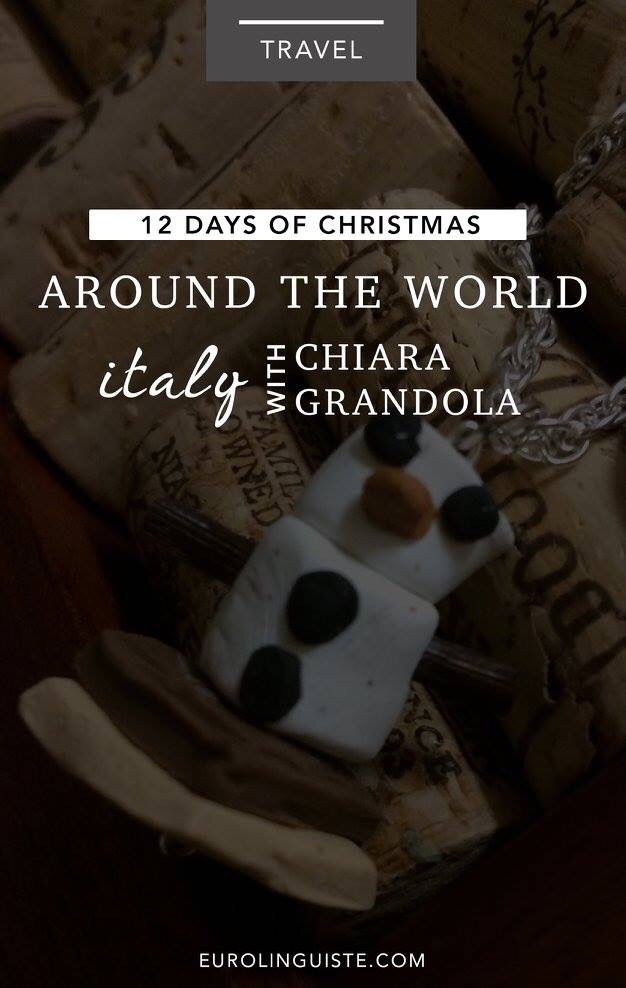Christmas in Italy with Chiara Grandola | 12 Days of Christmas Around the World Day 9

My name is Shannon Kennedy and I'm the language lover,…
About the Author // Chiara Grandola is the founder of Runaway Daydreamer. She’s a native Italian speaker and is passionate about all things languages, travel and entertainment.
The origin of Christmas in Italy
Italy stay true to its roots when it comes to Christmas and continues to focus on the same values the lie at the foundation of its culture: faith, family and food.
As we all know, Italy is a very religious country and most Christmas traditions and customs originate from Christianity. Not surprisingly, a Nativity scene – which is called “Il Presepio” or “Presepe” – is at the heart of the Christmas celebration and is proudly displayed in Italian homes, churches and piazzas.
Italians start decorating by putting up their “presepe” (and tree, of course!) on the Day of the Immaculate Conception, December 8. This is when the Christmas season officially kick offs, the lights go up and the markets full of local crafts take place on the streets.
How Christmas is celebrated in Italy today
A very popular Italian saying claims: “Natale con i tuoi, Pasqua con chi vuoi!” which basically means “Christmas with your family, Easter with whomever you want!”
And that’s exactly what Italians do.
There’s a huge family gathering during the holiday season, especially on two main occasions: Christmas Eve (la Vigilia di Natale) and Christmas’ day (il giorno di Natale).
Grandparents, aunts, uncles, brothers, sisters, cousins and relatives of all kinds gather to stay at home (and eat all day!) with loved ones.
Menus vary from region to region and even from city to city, but the Christmas Eve dinner – which precedes the Midnight Mass – is traditionally a meal with no meat.
January 6 marks the end of the holiday season. It’s the Day of the Epiphany when la befana—a kind of “good witch” – brings candy, sweets or toys to the well behaved kids and coal to the naughty ones.
‘La befana’ – whose name derives from the Greek word ἐπιφάνεια, epifáneia– is portrayed as an ugly old lady who rides on a broomstick. “L’Epifania, tutte le feste si porta via” (“Epiphany, carries away all festivities”) is what Italians say to indicate that Christmas time is over.
Christmas related vocabulary in Italian
| Italian | English |
| Albero di natale | Christmas tree |
| Addobbi | Decorations |
| Luci | Lights |
| Palline | Ornaments |
| Calza | Stocking |
| Santa messa | Holy mass |
| Buon Natale! | Merry Christmas! |
| Buone Feste! | Happy Holidays! |
| Auguri di stagione! | Seasons Greetings! |
| Carta regalo | Wrapping paper |
| Renna | Reindeer |
| Pupazzo di neve | Snowman |
| Fiocco di neve | Snowflake |
| Babbo Natale | Santa Claus |
| Castagne | Chestnuts |
| Regali | Presents |
| Gesù Bambino | Baby Jesus |
| Candela | Candle |
| Vigilia di Natale | Christmas Eve |
| Chiesa | Church |
| Stella | Star |
| Panettone | It means “big bread” and is a traditional festive cake studded with raisins and dried fruit |
| Torrone | a sweet candy made with toasted almonds |
| Pandoro | a yeasty golden cake from Verona |
| Cena in famiglia | Family dinner |
| Ghirlanda | Garland |
A traditional recipe that is prepared for Christmas
Calzoncelli
Notes
300 g of flour
A pinch of salt
50 g of sugar
1 eggs, lightly beaten
50 g of extra virgin olive oil
100 ml of white wine For the filling:
200 g of peeled and toasted almonds
125 g of sugar
Grated zest of one organic lemon
100 g of dark chocolate The dough:
Pour the flour in a medium bowl, adding the salt, sugar and lightly beaten egg to the center of the flour. Begin kneading the dough, adding in the oil and wine little by little. Knead dough until it is soft and elastic, return dough to bowl, cover with plastic wrap, then set aside for one hour. The filling:
Pour all the ingredients into a food processor and process until it becomes a smooth paste.
Preheat the oven to 180C. Roll out the dough as think as you can. Cut a long slice of dough about 1 in. wide. Using a spoon, place filling down the length of the slice of dough then fold the sides over to create a tube like shape that covers the filling. Use a knife to cut one inch pieces and then place them on a baking tray. Repeat until either dough or filling is used up.
Bake the calzoncelli for about 15-20 minutes or until golden brown. Adapted from Juls Kitchen
Would you like to download a copy of this recipe and vocabulary? Enter your email below and I’ll send you the password and link to the page on this site where all 12 of the recipes and vocabulary sheets will be posted!

My name is Shannon Kennedy and I'm the language lover, traveler, and foodie behind Eurolinguiste. I'm also the Head Coach of the Fluent in 3 Months Bootcamp, co-founder of Women in Language, and former Resident Polyglot at Drops.



